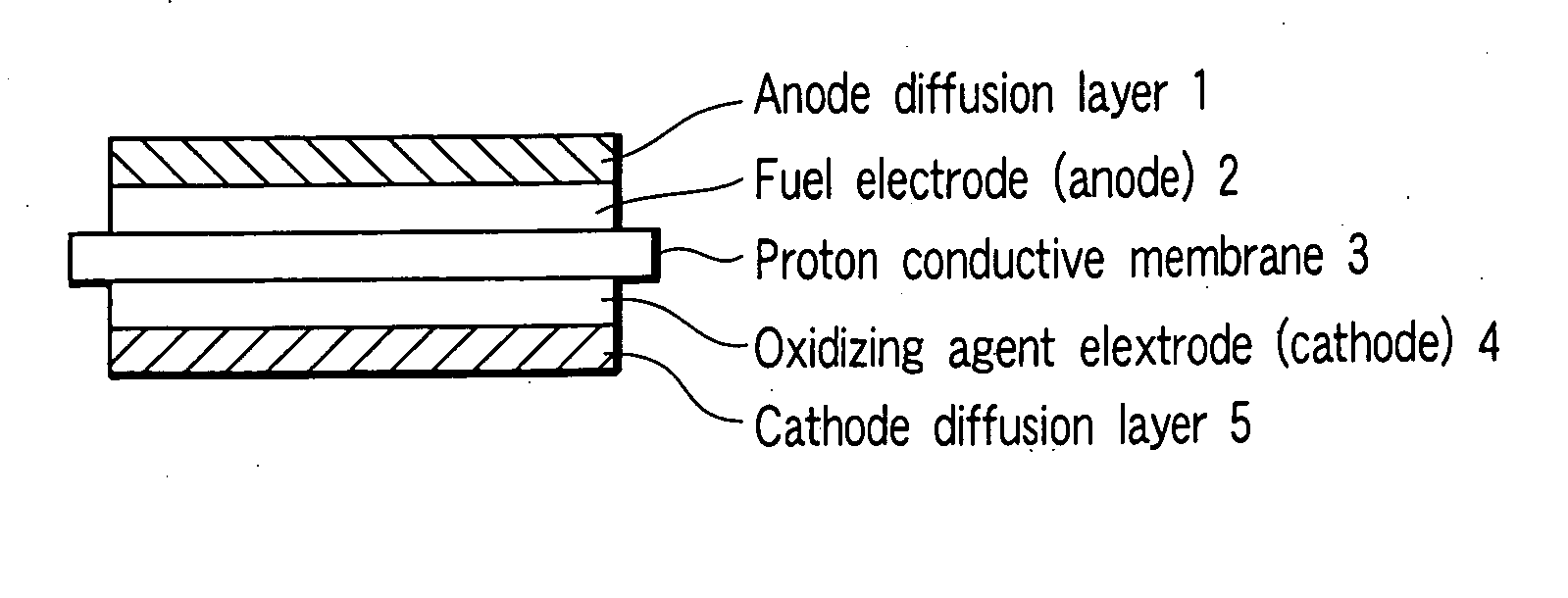Liquid fuel cell, membrane electrode assembly and cathode
a membrane electrode and fuel cell technology, applied in the field of liquid fuel cells, can solve the problems of insufficient study of the optimization of the cathode of the dmfc, detrimental effect of over phenomenon on the electrode, and inability to obtain sufficient fuel cell performance with a small air supply amount. achieve excellent low-air performance
- Summary
- Abstract
- Description
- Claims
- Application Information
AI Technical Summary
Benefits of technology
Problems solved by technology
Method used
Image
Examples
example 1
[0071]
[0072] In the first step, weighed was 0.4 g of a fibrous supported catalyst (herein after referred to as “catalyst B”) comprising a herringbone type cabon nanofiber carrier having an average diameter of 200 nm, a specific surface area of about 250 m2 / g, and an aspect ratio not less than 50 and Pt particles supported by the cabon nanofiber carrier in an amount of 50% by weight. Also weighed was 1.6 g of a granular supported catalyst (herein after referred to as “catalyst C”) comprising a carbon black carrier having a primary particle diameter of about 40 nm, which is smaller than half the average diameter of the catalyst B, a specific surface area of about 800 m2 / g, and a DBP absorption value of 300 mL / 100 g and Pt particles supported by the carbon black carrier in an amount of 50% by weight. The catalysts B and C thus prepared were mixed with 5 g of a pure water, 5 g of a 20% NAFION solution and 20 g of 2-ethoxy ethanol while stirring sufficiently the mixture, followed by disp...
example 2
[0080] Weighed was 0.3 g of the fibrous supported catalyst B used in the cathode in Example 1. Also weighed was 0.1 g of a fibrous supported catalyst (hereinafter referred to as “catalyst A”) comprising a herringbone type cabon nanofiber carrier having an average diameter of 80 nm, which is smaller than that for the catalyst B, a specific surface area of about 300 m2 / g, and an aspect ratio not less than 50 and Pt fine particles supported by the carbon nanofiber carrier in an amount of 50% by weight. Further, weighed was 1.6 g of the granular supported catalyst C equal to that used in Example 1. The catalyst A corresponds to the first carbon nanofiber, and the fibrous supported catalyst B corresponds to the second carbon nanofiber. A cathode was manufactured as in Example 1 by using the supported catalysts A, B and C thus weighed. A DMFC was manufactured as in Example 1 by using the cathode thus manufactured and the cathode was evaluated, with the result as shown in Table 1. It can b...
example 3
[0084] Used was a supported catalyst for the cathode equal to that used in Example 2. Also, a cathode was manufactured as in Example 2, except that the thickness of the catalyst layer was set at 60 μm. Further, a DMFC was manufactured as in Example 1 by using the cathode thus obtained, and the cathode was evaluated, with the result as shown in Table 1. The comparison between the result of Example 3 and the result of Comparative Example 3 described previously indicates that, if the thickness of the catalyst layer is set at 60 μm or less, it is possible to improve the voltage performance at the low air feeding rate and the voltage drop under the methanol concentration of 1.5 M.
PUM
 Login to View More
Login to View More Abstract
Description
Claims
Application Information
 Login to View More
Login to View More - R&D
- Intellectual Property
- Life Sciences
- Materials
- Tech Scout
- Unparalleled Data Quality
- Higher Quality Content
- 60% Fewer Hallucinations
Browse by: Latest US Patents, China's latest patents, Technical Efficacy Thesaurus, Application Domain, Technology Topic, Popular Technical Reports.
© 2025 PatSnap. All rights reserved.Legal|Privacy policy|Modern Slavery Act Transparency Statement|Sitemap|About US| Contact US: help@patsnap.com


